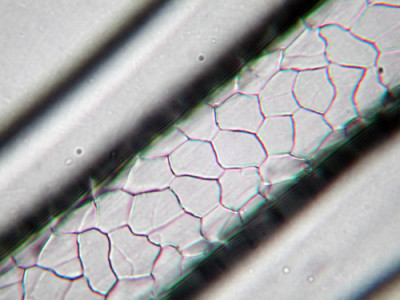Hair (Human and Animal)
Over the years, a wide variety of clients from forensic, civil, and industrial arenas have requested scientific hair analyses from Microtrace. A typical hair analysis, which may relate to animal or human hair, involves the identification of unknown material and possibly a comparison to a known or reference sample. In this capacity we have completed work for crime laboratories, animal welfare organizations, pharmaceutical, cosmetic, agricultural, brush, wig, and paper companies, to name a few. Our analysis of hairs generally revolves around microscopy, with a focus on morphology for identification and microchemistry for characterization of treatments.
Identification – Human and Animal
Once the material has been identified as hair, other questions can be investigated. This usually begins with determining whether the sample is of human or animal origin. With human hairs, it may be possible to determine the ancestry and somatic origin of the hairs. Animal hairs can be further classified to various taxonomic groups. This often involves special sample preparation techniques including scale replica casts, transverse, and longitudinal cross-sections. Our hair reference collection is an invaluable resource when analyzing both animal and human specimens.
Comparisons
Forensic hair comparisons are typically used as first step toward establishing or refuting the common origin of hairs from multiple sources. There is no substitute for microscopy when sorting or screening large numbers of hairs, often as a prelude to mitochondrial DNA analysis. There is greater significance with regards to common origin for hairs with both similar microscopical appearances and mtDNA profiles than with just mtDNA evidence alone.
Supplemental Analysis
Additional insights concerning the history of the hair can often be elucidated through careful examination. The condition of the root can distinguish hairs that were forcefully removed from those that were naturally shed and can also determine if a hair is suitable for nuclear DNA testing. The root, in conjunction with the appearance of the proximal shaft, can also be used to identify post-mortem root banding. The condition of the distal and proximal ends without roots can be used to determine if hairs taper naturally, are split, were cut, sliced by a razor, or broken.
Cosmetic treatment (e.g., bleaching or dyeing) can be identified through microchemical staining along with the microscopic appearance of the cortex. Dyes, if present, can be extracted and analyzed in their own right, providing additional information and discrimination. A wide variety of miscellaneous observations can be used to identify thermal degradation, diseases, parasites, insect, and fungal activity on hairs.
Research and Collections
One key to a supportable hair identification is reliable reference collections. Microtrace maintains and curates a large collection of animal and human hairs featuring numerous species, body areas, and treatments. These collections are used for internal research and to support casework results. Microtrace scientists have published, presented, and taught workshops on the results of their hair research around the world. Select hairs have been prepared as a collection and are available for sale.
How May We Help You?
Contact usto discuss your project in more detail.








